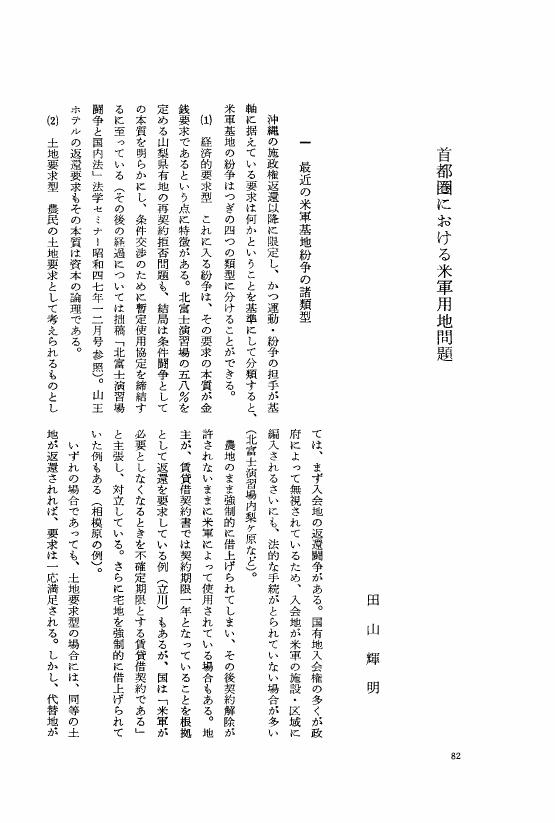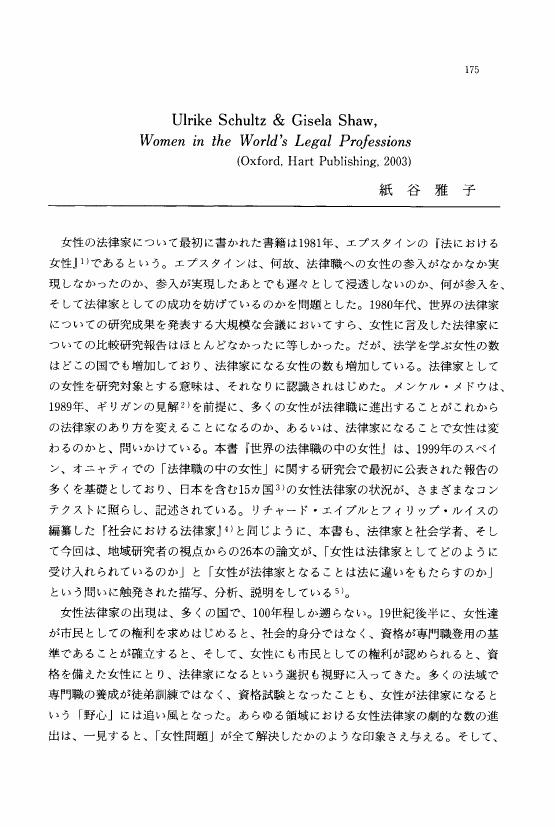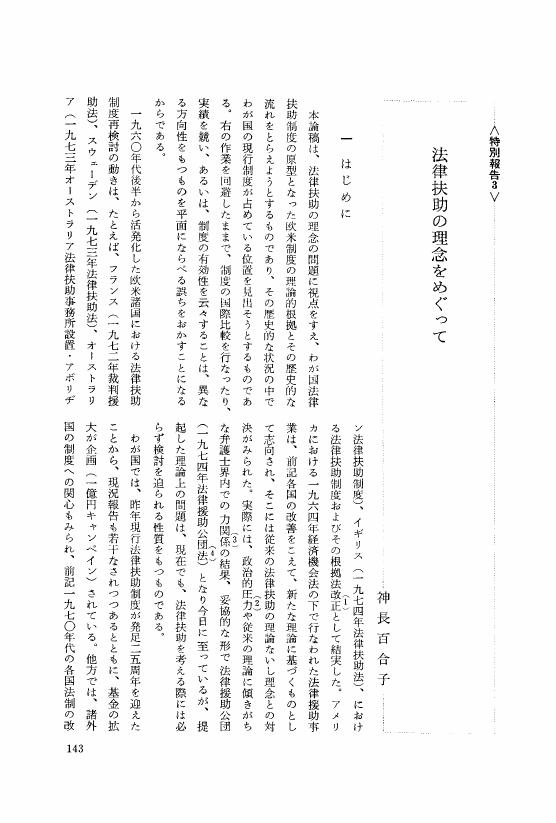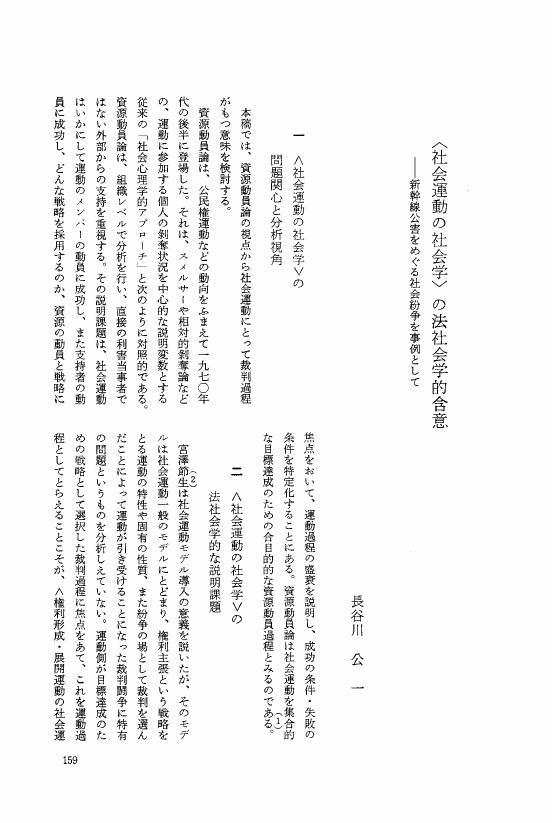1 0 0 0 OA <暴力の法社会学> に向けて-基調報告
- 著者
- 石田 眞
- 出版者
- 日本法社会学会/有斐閣
- 雑誌
- 法社会学 (ISSN:04376161)
- 巻号頁・発行日
- vol.2001, no.54, pp.1-12,257, 2001-03-30 (Released:2009-01-15)
- 参考文献数
- 30
Violence has existed and still exists as a fact of our every day life, but has not been on the surface as an object of social science or the humanities in Japan. Rather, it has been ignored. However, recently the subject of violence has come into sight in social science and the humanities. If the 20th Century was the "Century of Violence", then the 21st Century will be the "Century of Facing Violence". Therefore, the theme "Law and Violence" is demanded by the times.The subject of violence has been ignored even in jurisprudence. Although violence is an essential part of modern law, it has been invisible. First, modern law designated violence as the use of unlawful force against another. That is to say, the use of force within the law or with the law's permission was ignored. Second, modern law is divided into the public and private spheres, with the law only interfering in the former (public sphere), ignoring violence in the private sphere like the home and school. Third, modern law considers the courts, as places of judgement, to be a world free from violence, yet ignores the violence that occurs there (such as second rape).The purpose of my paper is to prepare for the socio-legal studies of violence. It is an attempt to put together socio-legal research related to violence. In preparing it, I first focused on the institutional area. I asked who exercises legal force and how. Research in this area comes from a great deal of substantiated evidence concerning punishment, police, public prosecutors and courts. Second, I looked at the cultural and historical area. Here, I asked what the differences are in the make up of law's violence in different cultures and in different eras. Research in this area was accumulated from legal anthropology and the historical sociology of law. Third is the area of law itself. Here, I asked what impact law's violence has on the law. Research into the area of the jurisprudence of violence has just begun. I have attempted in this paper to theorize on the socio-legal studies of violence by analyzing critically modern law through an understanding of the problem of violence that has developed in the law.
1 0 0 0 OA 首都圏における米軍用地問題
- 著者
- 田山 輝明
- 出版者
- 日本法社会学会/有斐閣
- 雑誌
- 法社会学 (ISSN:04376161)
- 巻号頁・発行日
- vol.1973, no.26, pp.82-86, 1973-10-10 (Released:2009-01-15)
- 著者
- 紙谷 雅子
- 出版者
- 日本法社会学会/有斐閣
- 雑誌
- 法社会学 (ISSN:04376161)
- 巻号頁・発行日
- vol.2005, no.62, pp.175-179, 2005-03-30 (Released:2011-04-13)
- 参考文献数
- 11
1 0 0 0 OA 法律扶助の理念をめぐって
- 著者
- 神長 百合子
- 出版者
- 日本法社会学会/有斐閣
- 雑誌
- 法社会学 (ISSN:04376161)
- 巻号頁・発行日
- vol.1978, no.30, pp.143-152, 1978-03-30 (Released:2009-01-15)
- 参考文献数
- 33
- 著者
- 神長 百合子
- 出版者
- The Japanese Association of Sociology of Law
- 雑誌
- 法社会学 (ISSN:04376161)
- 巻号頁・発行日
- vol.2004, no.61, pp.147-165,218, 2004
This paper presents an analysis on the professional work and consciousness of the Japanese women lawyers who practice law in the metropolitan area of Tokyo. It is based on the research of women lawyers conducted in 1998 supported by Grant-in-Aid for Scientific Research of the Japan Society for the Promotion of Science.<br>The frame of the research is to see if the international trend of the female bar to commit to the women's cause, especially "Women's Rights, " or feminist perspectives has any effect on Japanese legal practice by women lawyers. My former research of 1991 (cf. Kaminaga & Westhoff, "Women Lawyers in Japan: Contradictory Factors in Status, " in Shultz & Shaw eds. Women in The World's Legal Profession, 2003) suggested that women lawyers held a very special position in Japanese society-a kind of limbo between the general low social status of Japanese women and the very elevated status of the elite profession of law. Following up this result in a larger scale with more sophisticated design, I conclude that the same picture still applied to Japanese women lawyers at the turn of the century. The status factors reflected in their everyday practice and their attitude toward the representation of women clients and the "Women's Rights" cause.
1 0 0 0 OA ジェンダー的日常存在の純化とその解体
- 著者
- 坂本 正光
- 出版者
- 日本法社会学会/有斐閣
- 雑誌
- 法社会学 (ISSN:04376161)
- 巻号頁・発行日
- vol.2001, no.54, pp.59-79,259, 2001-03-30 (Released:2009-01-15)
- 参考文献数
- 12
In sum, the author of this paper wants to assert that the notion of gender that commonly works as a denominator to sever constructed character of sex and sexuality out of biological sex and sexuality might cease to function due to diversified interests of feminism activists. The paper examined briefly a history of feminism in Japan as compared with that in the United States for the last three decades. It came out with the observation that mighty emergence of minorities' voices other than essentialists' might bring out a breakdown of concept of gender as an adhesive of various interests. In conclusion, the author of this paper asserts the notion of gender should be more itemized and individualized to reflect the real world through its reconstruction.
- 著者
- 坂元 真一
- 出版者
- The Japanese Association of Sociology of Law
- 雑誌
- 法社会学 (ISSN:04376161)
- 巻号頁・発行日
- vol.2002, no.57, pp.224-241,262, 2002
In 1940, Japan revised the Korean Civil Act, and mandatorily added "Japanese-style" surnames to all Koreans (so called "Renaming Policy in Korea"). At the same time, this Act allowed all Koreans to adopt a child who is not the member of the adoptive father's patrilineal clan. After liberation, all of such "non-customary" adoptions were invalidated retrospectively, and South Korean courts held this decision for more than 40 years. Nevertheless, in 1994, the Supreme Court of South Korea, overruling the precedents, declared that the "non-customary" adoptions done on the basis of 1939 Act were/are valid.<br>This paper reviews the appropriateness of this 1994 Supreme Court decision. To undertake this analysis, the logical relation between the "Japanese-style" surnames and the "non-customary" adoptions is mainly discussed. The first Korean Civil Code of 1960 allowed the "non-customary" adoption without forcing any "Japanese-style" surnames. This fact clearly proves that the "Japanese-style" surname is one thing: the "non-customary" adoption is another. Hence, even the former was declared "null and void <i>ab initio</i>" by the ordinance "Restoration of Korean Names" of 1946, the latter cannot be automatically invalidated. The "non-customary" adoptee based on the Act of 1939, however, had a right to succeed the adoptive father's "House", which was prohibited by the Korean Civil Code of 1960. The succession of the "House" by the adoptee of deferent patrilineal clan caused a serious "Japanization" to the legal identity of Korean customary "House".<br>In conclusion, the 1994 Supreme Court decision is proper, as far as the validity of the "non-customary" adoption on the base of the 1939 Revised Act. However, the right of the "non-customary" adoptee to succeed the adoptive father's "House" should be invalidated retrospectively, in the light of making a distinction between "modernization" and "Japanization" in the history of Korean Law and Society.
1 0 0 0 OA リアリズム法学覚書
- 著者
- 鵜飼 信成
- 出版者
- 日本法社会学会/有斐閣
- 雑誌
- 法社会学 (ISSN:04376161)
- 巻号頁・発行日
- vol.1952, no.2, pp.98-105, 1952-04-15 (Released:2009-04-03)
- 参考文献数
- 6
1 0 0 0 主体と制度:法主体と法制度
- 著者
- 日比野 勤
- 出版者
- The Japanese Association of Sociology of Law
- 雑誌
- 法社会学 (ISSN:04376161)
- 巻号頁・発行日
- vol.2006, no.64, pp.43-59,275, 2006
Human entities are of a psychic existence. They are of a pathos-like, passive existence and as such, need to act towards the outside world. The autonomous existence of an entity emerges when it actively engages the world, and through a common actual engagement with the world emerges the autonomy of an organisational entity. However, as a mechanistic way of thinking develops, the actual psychic existence of the entities comes to be replaced by a physical psychic existence. In such circumstances, although entities are still autonomous and make decisions on their own, they are unable actively to engage with the outside world. They are merely elements in an operational sequence, and the autonomous existence of not only the individual entities, but also of organisational entities is denied in such a situation. In recent years, with the growing influence of spiritualism, people increasingly become a virtual psychic existence. Here, the distinction between reality and the virtual world becomes blurred, and occasionally, a forceful, possibly even violent, realisation of the virtual world is attempted, although this does not mean that there is any actual commitment to the world.<br>Law cannot be immune from such transformation of entities, but the legal system has, however, so far been unable to cope with such entities in transformation. Problems such as the appropriateness of using brain-death as a criterion for medical death, refusal of blood transfusions by Jehovah's witnesses, and the control imposed on Aum-Shinrikyo as an organisation should be understood in this context.
1 0 0 0 OA <社会運動の社会学> の法社会学的含意
- 著者
- 長谷川 公一
- 出版者
- 日本法社会学会/有斐閣
- 雑誌
- 法社会学 (ISSN:04376161)
- 巻号頁・発行日
- vol.1989, no.41, pp.159-163, 1989-04-20 (Released:2009-01-15)
- 参考文献数
- 4
1 0 0 0 OA 伊藤護也著『法社会学方法論の批判的検討-現代経験主義法学の批判的検討を中心として-』
- 著者
- 荒川 重勝
- 出版者
- 日本法社会学会
- 雑誌
- 法社会学 (ISSN:04376161)
- 巻号頁・発行日
- vol.1991, no.43, pp.174-179, 1991-04-30 (Released:2009-01-15)
1 0 0 0 地区計画策定への住民参加と公共的主体の条件
- 著者
- 宗野 隆俊
- 出版者
- 学術雑誌目次速報データベース由来
- 雑誌
- 法社會學 (ISSN:04376161)
- 巻号頁・発行日
- vol.50, pp.140-144,287, 1998
The land is not only subject to each owner, but also must be under the public control. This is clearly true of neighborhood-building process. In this article, I treat the district-planning as model case of consensus-making among various residents who has his or her own interests respectively. Each resident participates in the process of making rules of how to use his or her own land, how to reside in neighborhood surrounding them. Because of their two contrary orientations (one, to maintain the present state as a quiet residental area, the other, to make efficient economic use of the land), two parties stood in opposition. In this case, although the autonomous participation of residents in the district-planning process is of great importance, the involvement of planner as specialist of planning is inevitable, too. So, it must be investigated how to make the best use of his knowledge, experience, information, and persuasiveness as resources for enabling each participants to argue and agree on the present and future of the area. The condition of agreement can be seeked in the consensus-making process in which each participant shares 'common recognition' that manifests shared intention to maintain the present residental environment that enables to live under the fine condition.
- 著者
- 長谷川 貴陽史
- 出版者
- 有斐閣
- 雑誌
- 法社会学 (ISSN:04376161)
- 巻号頁・発行日
- no.63, pp.127-142, 2005
- 被引用文献数
- 1
- 著者
- 古山 真知子
- 出版者
- 有斐閣
- 雑誌
- 法社会学 (ISSN:04376161)
- 巻号頁・発行日
- no.64, pp.268-273, 2006
- 著者
- 樋口 陽一
- 出版者
- 有斐閣
- 雑誌
- 法社会学 (ISSN:04376161)
- 巻号頁・発行日
- no.53, pp.46-55, 2000
1 0 0 0 OA 社会規範としての「誠意」について
- 著者
- 吉田 勇
- 出版者
- 日本法社会学会/有斐閣
- 雑誌
- 法社会学 (ISSN:04376161)
- 巻号頁・発行日
- vol.1996, no.48, pp.199-203,244, 1996-03-30 (Released:2009-01-15)
In Japan, the frequent use of word "Sei-i" is observed in the process of negotiations and dispute resolutions. The essential core of "Sei-i" originated in the Japanese confucianism of the Tokugawa period. Since then, it has been gradually transformed into a complex of traditional, modern and contemporary types of "Sei-i". Therefore, Japanese "Sei-i" has various meanings today.Careful observation indicates that sometimes a sence of "Sei-i" gives normative influence on human relations, though it often plays only an emotional role. In that case, the word "Sei-i" is used to express a normative sense which people have in mind, especially when the injured party negotiates with the injurer for apology and compensation. And it is worth notice that both persons think highly of "Sei-i", but they often understand the same contents of it quite differently.A few scholars have already studied some aspects of "Sei-i", but they don't focus their concerns upon its normative sense. This paper deals with its normative sense in the process of negotiations and disputes between the injured party and the injurer.The main purpose of this paper is to construct theoretical model of normative contents and social functions of "Sei-i". Normative contents of "Sei-i" are classified into procedural contents and substantive ones, and both contents are constructed as a set of normative rules.This paper is the first step to the heuristic study of "Sei-i" as a sense of social norm.
1 0 0 0 ざわめきとしての法
- 著者
- 毛利 康俊
- 出版者
- 日本法社会学会
- 雑誌
- 法社会学 (ISSN:04376161)
- 巻号頁・発行日
- vol.2007, no.67, pp.109-122, 2007





